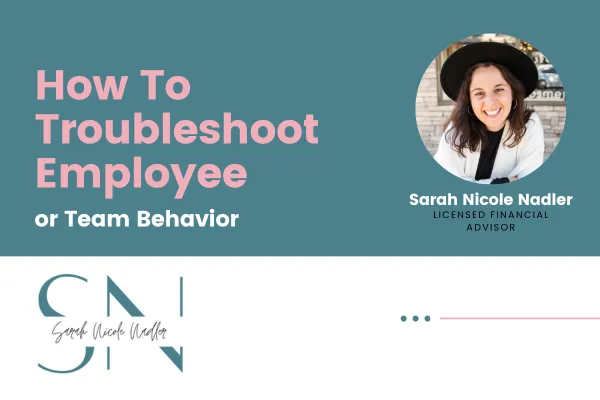
How To Troubleshoot Employee or Team Behavior
A very common confession I hear when I analyze businesses is that the owner or manager isn’t good with confrontation and lets things slide when they shouldn’t.
When the executive backs away from enforcing the rules and protocols, they lose respect from the staff, particularly those staff who work hard and take offense at others who slack off.
I hired my first employee before my 16th birthday. Being a business owner or mentor my entire adult life, I can safely say this issue of troubleshooting behavior is the biggest headache of most 6- and 7-figure businesses.
The reason this happens is the executive has few or no tools for troubleshooting the employee or team member's behavior...and they quickly run out of said tools! So in this episode of The Six Figure Biz, I’m going to take you behind the scenes and show you my entire process for troubleshooting why a team member is misbehaving, and what to do about it.
So, let’s pull this problem apart.
How to Troubleshoot Employee or Team Behavior
FREE Troubleshooting Employee Behavior Guide
Get my Troubleshooting Employee Behavior Guide with step-by-step instructions sent right to your inbox.
With every episode of Fierce Feminine Finance, I like to empower you with a POWERFUL free resource that goes with the episode which you can implement right away to create some of the same results, if not better, in your business.
This week, since we are talking about the root cause of employee or team misbehavior, I put together a Troubleshooting Employee Behavior Guide so you know the best questions to ask your team.
After going through this freebie you will be able to ask the correct questions from your employees and team so you can get to the bottom of how they are acting and resolve it.
You can download it right away by clicking on the button above 👆
Identifying The Problem
First, let’s identify the types of conversations that generally lead to confrontation. Here are three scenarios:
1. You tell an employee that something needs to be done.
A typical example is when you need someone to stay late. This cuts into their personal plans and the employee lashes back at the order.
Or maybe it’s a new task that is assigned to someone who already feels they are overloaded.
Or perhaps it’s a new way of doing something (like answering the phone) that the team member is dead set against. The point is the order is resisted and sometimes that resistance can turn downright ugly, or at the least confrontational.
2. Disciplining someone.
You have observed a violation of policy and now you need to take it up with that person. But they feel like there were extenuating circumstances that aren’t being taken into account and so feel picked on and get defensive.
3. You need to correct something an employee is doing incorrectly.
Even correcting an honest mistake due to lack of training or forgetfulness can create unwanted responses from the staff member. The executive may be doing this in a civil matter but if the staff member feels like there was no problem in the first place, then they feel invalidated and to that degree mistreated.
In all three of these instances what we have is the executive, seeing something that needs to be done differently, ordering a specific change that is met with resistance.
And when this lash back has emotional overtones to it (like tears or anger or frustration), then we’ve reached the confrontation zone that executives hate so much.
How To Solve It
To solve this, we need to prioritize one thing right away:
Create an atmosphere where the communication is civil.
Regardless of whatever is under discussion (whether an order was given, you're having to discipline them or correction is being undertaken) it should all be done in a cordial manner. To do this, create policy that dictates what type of communication is allowed. Policies are rules that everyone has agreed to abide by.
If you downloaded the Troubleshooting Employee Behavior Guide above, you may have noticed a suggested policy that goes like this:
“All communication should be cheerful. Despite what is going on with you on a personal level, you should always appear professional, enthusiastic, and caring. If you cannot do so at any time, make arrangements with your supervisor to have your post covered until you can.”
This policy has particular importance as only when people are cheerful and civil can true discourse occur.
So, let’s see how this policy can defuse our situation; when the response to a correction, discipline or order is negative.
The first step is to go back to the agreement that originally existed and reaffirm it. They may need to take a walk to calm down, but whatever it takes, you need to enforce the policy of cheerful communication. For once they are cheerful again, you can then have a logical conversation.
Now obviously if the subject of the conversation is upsetting them, it is highly unlikely that they will grin and bear on. But you need to stop them from attacking you and you need them to be willing to have sensible communication. Accomplish this first, and everything else is much easier.
Inside the Troubleshooting Employee Behavior Guide, you'll find half a dozen examples of ways to de-escalate a conversation.
Next, determine why you are getting resistance.
Now that the staff member has calmed down, you can proceed to the next step which is sorting out why you are getting resistance. If you examine the push back you get from staff, you’ll find it normally traces back to three distinct problems:
1. The staff member is overwhelmed by everything on their plate. This can leave the staff member anxious and frustrated and cause them to lash out at executives who the staff member views are just adding one more thing to their overloaded area.
2. The staff member is uncertain on how to perform what is asked of them and so resists doing it.
3. The staff member is unwilling to do what is asked of them.
So, the next step is to identify which of these three situations you have. Why is this so important? Because each problem requires a very different solution. Apply the wrong solution and you will create an entirely different problem.
To see this, let’s look at two of these problems, the two that often get confused; the uncertain staff member and the unwilling one.
The solution for the uncertain staff member is to train or correct them.
The solution to the unwilling one is to discipline them.
What happens if you misapply the solutions? Well, if you try to re-train a staff member who knows how to do the task but is simply unwilling, you obviously will get nowhere. They already know how to do what is asked of them, they are just unwilling to do so.
On the flip side, what happens if you try to discipline someone who is simply confused?
Well, discipline is basically a sequence of consequences, each one more severe than the previous one. As an example of a sequence, let’s say the first step is a verbal warning. The second step then is a more stern warning with a documentation that the staff member signs. The third step is an even more serious warning that is also documented. At the fourth step the staff member is suspended for a day without pay. The last step is dismissal.
The point in this approach is you are trying to find what level of consequence will get through to the staff member that you are serious in requiring them to follow procedure and policy.
In most instances, discipline rarely has to go beyond the first or second step. If it does, there is a good likelihood that you have hired the wrong person.
So, discipline is an application of consequences. This tells us why it won’t work when the problem is confusion. If you have a staff member who is confused on how to perform a task, threatening them with possible suspension or dismissal will not suddenly make them understand.
Quite the contrary.
The added stress will undoubtedly make it more difficult to learn as most people don’t absorb information well under duress.
This then, is why it is so important to determine whether your staff problem is due to an overload, a confusion or an unwillingness. Misunderstanding the problem and applying the wrong solution will obviously upset the staff member and now you created the very emotionally charged discussion you were trying to avoid. Execute the correct management solution.
Once you have identified which problem you have, the last step is to apply the correct solution. This means: If the problem is the staff member is overloaded, you have to analyze the area to understand why it is overloaded. At this point, you will either reorganize the area making it more efficient, or bring on additional personnel.
To do this step you must know how to analyze overloaded areas correctly. If you make the wrong move here, you will either bring on an employee prematurely (thus cutting into profits) or you will keep staff on in overloaded areas resulting in poor morale or even turnover.
If the problem is confusion, you obviously need to find the source of the confusion and either train them on it or get them corrected (if they have already been trained).
To do this step, you minimally need detailed write ups of how the task is to be performed (so there is no misunderstanding of exactly what is expected), and role playing exercises and drills that allow the staff member an opportunity to practice the skill set before going ‘live’.
If the problem is they are unwilling to do what is being asked of them, run the sequence of discipline steps until they are willing to do what is asked of them or they resign or are dismissed.
To do this step you need to:
Have your policies in writing.
Have the sequence of disciplinary actions figured out.
Know how to correctly document the conversations.
This last is to protect you in case the situation ever turns legal.
In Summary
Alright, let’s recap. To reduce the confrontational aspect of dealing with staff, the following points should be understood by executives:
Have policy that dictates how communication is allowed in the business, so that your conversations can be kept civil.
Determine why the resistance is occurring (is it overload, confusion, or unwillingness).
Apply the correct staff management solution.
As tools to aid the above, make sure your policies and procedures are all in writing, that you can analyze overloaded areas, that you know how to role play and drill the staff, and that you have a laid out sequence of consequences.
If you follow the above, you should find dealing with staff is far, far more effective with so much less confrontation.
Once you have a great team in place, you need a strategy to increase efficiency and scale your business in a profitable way. I can help. Choose a time below to connect with me: https://calendly.com/sarahconsulting/join
A Beginner-Friendly Class On Investing & Building Passive Income for Business Women and Entrepreneurs
Get my exclusive strategy for turning your intellectual property into passive income and growing it to 5-figures per month and beyond! FREE


© Copyright 2024 Sarah Nicole Nadler LLC. All rights reserved.
2022 All Rights Reserved.



